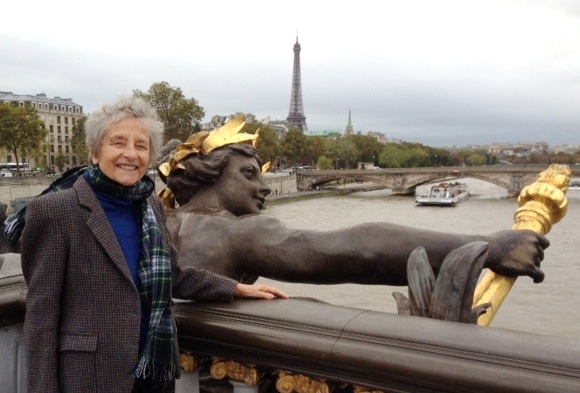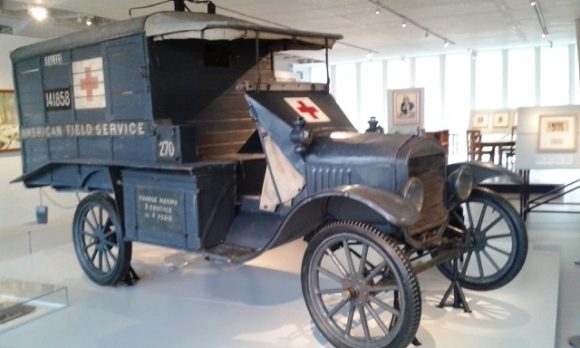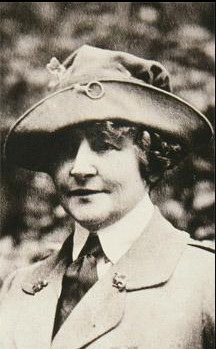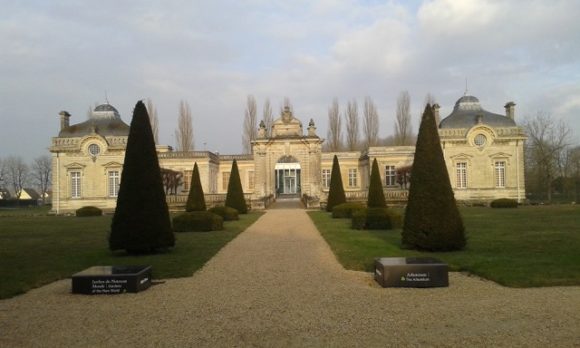
La Fayette nous voilà (La Fayette, here we are) are the famous words General John J. Pershing , commander of the American Expeditionary Forces, is supposed to have pronounced on July 4, 1917 during the commemoration near the tomb of the Marquis de La Fayette at the Picpus cemetery in Paris. The entry of the Americans in World War I was a way to return the favor to the French for being an ally throughout their history. The Franco-American museum in Blerancourt, in a concrete way, furthered this enduring amity.
From the outbreak of the war even before America declared war on Germany on April 6, 1917, a segment of US public opinion, wanted the country to enter the conflict. Among the Americans living in Paris (there were 100,000 of them at the time), private associations such as the American Field Service, intellectuals, writers, and artists offered to join the allied cause. Many young people volunteered as ambulance drivers.

One of them was Anne Morgan (1873-1952) third daughter of John Pierpont Morgan, Sr., banker and art collector.

She started raising funds to equip the French army as early as 1915, and in 1917 chose the village of Blerancourt, which was in the midst of total devastation, to carry out her humanitarian aid to the wounded soldiers and civilian population.
The Aisne department (a department in France is the US equivalent of a county) was one of the worst hit battle fields. It is sadly remembered for being the scene of three bloody campaigns all called Chemin des Dames in 1914, 1916 and 1917 . In April 1917 alone, 100,000 French soldiers died on that front.
Morgan worked from the barracks she erected on the terraces of the Chateau de Blerancourt – a grand 17th century private residence built by the architect who designed the Luxembourg Palace, for Marie de Medicis. In 1919, Morgan bought the ruins of the chateau and started its restoration. In 1923, she created the association of the Friends of Blerancourt and the following year founded what was to become the Franco-American Museum.
The restored 17th century elegant rooms of the chateau are quite fitting for the historical part of the museum. French explorers -Jacques Cartier, Father Jacques Marquette-Cavelier de la Salle, Champlain and others – left their trace in the geography books of the New World. Their names are still vivid but the lands they discovered – from Canada to Louisiana – have long severed ties with France. Only the St Pierre et Miquelon archipelago remained part of the mother country.
La Fayette was the first Frenchman to enlist in the War of Independence in 1777. With a great deal of panache, in October 1781, the 6,000 men of Count of Rochambeau, joined the Continental Army of George Washington, later the fleet of Admiral de Grasse encircled the English forces. The combined effort ended in the victorious battle of Yorktown and the rendition of the British.
Was its support in the conflict beneficial to France? Some historians do not think so. Claude Moisy, former president of Agence France Press (AFP), journalist and specialist in the political history of the US, is one of them and goes as far as to believe that France was caught in a fool’s game.
During a talk Moisy gave to the France-England Association in 2007, he described the sequence of events, as he sees it: the US Congress had promised not to sign a separate peace with the English, but it did on November 30 ,1782, after secret negotiations.
The real objective for the American government was to resume, as soon as possible, trade and economic relations with Great Britain. Washington had dispatched Benjamin Franklin to Paris. He soon became the coqueluche (the rage) of the Paris society and suspiciously close to it. The author describes Paris at that time as a “panier de crabes” (can of worms), crawling with spies and foreign agents.
The final peace treaty was only signed 10 months later in September 1783, with the participation of Holland and Spain.
2018, – the year of commemorations marking the 100th anniversary of the Great War- started appropriately with the “Cesars” selecting Au Revoir Là Haut, as best film and best director. It is based on the 2013 Prix Goncourt novel by Pierre Lemaitre. Two soldiers- nicknamed “poilus” during the Great war- experience the horror of trench war, including being buried alive . (the writer may have been inspired by what happened to the poet and art theoretician Guillaume Apollinaire, who was buried alive three times, underwent trepanation and died in 1918.). The story continues after the war, when the two heroes, traumatized and disfigured by injuries, witness the sordid traffic of war memorials.

The Blerancourt museum is a lovely, luminous building,, located at about two hours drive north-east of Paris. The World war I activities of Anne Morgan -including her ambulance, uniform, wartime memorabilia and mobile library- are brought back to life.
The Art department has just been renovated and contains more than 400 works. The collection includes paintings by impressionist Childe Hassam, John Singer Sargent and many others. The arrival of American troops in St Nazaire was caught in Art Deco style by French artist Jean Emile Laboureur in 1918. Singer and dancer Josephine Baker, appears on the cover of the “Revue Nègre“. She was born in St Louis, joined the Resistance and is an idol in France.
Editor’s Note: This is the opinion of Nicole Prévost Logan.

Nicole Prévost Logan
About the author: Nicole Prévost Logan divides her time between Essex and Paris, spending summers in the former and winters in the latter. She writes a regular column for us from her Paris home where her topics will include politics, economy, social unrest — mostly in France — but also in other European countries. She also covers a variety of art exhibits and the performing arts in Europe. Logan is the author of ‘Forever on the Road: A Franco-American Family’s Thirty Years in the Foreign Service,’ an autobiography of her life as the wife of an overseas diplomat, who lived in 10 foreign countries on three continents. Her experiences during her foreign service life included being in Lebanon when civil war erupted, excavating a medieval city in Moscow and spending a week under house arrest in Guinea.